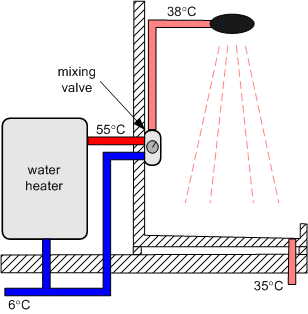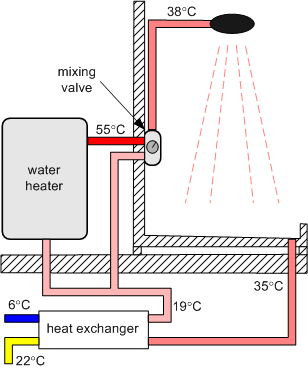What is WWHR?
Waste Water Heat Recovery or WWHR is the use of a heat exchanger to recover some of the heat from the waste water from activities such as dish-washing, clothes washing and especially showering. This is also referred to as water heat recycling, grey water heat recovery, drain water heat recovery(DWHR) or sometimes shower water heat recovery.
It is important to note that it is not the drain water itself that is re-used, only the heat that it carries is partially recovered. All WWHR systems work by preheating the incoming cold water using the heat contained in the drain water.
For the remainder of this discussion, we will focus on the application of WWHR in combination with a shower, since this is most common and also gives the best opportunity for energy savings in a domestic setting. Also, because of the simultaneous flow of drain water from the shower and cold water from the utility, a larger variety of WWHR systems can be implemented without the need of storing the drain water.
WWHR makes a lot of sense, considering that domestic drain water still carries a lot of energy: water that is used in the shower has a temperature of 38-40°C (100-104°F) and enters the drain at 35-37°C (95-99°F). This means that approximately 90% of the energy that has been used by the water heater to warm up this water is wasted.
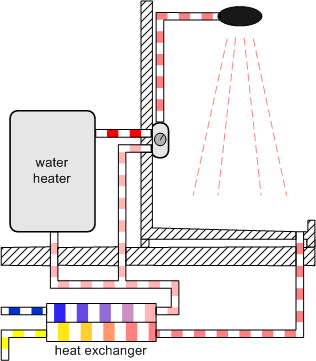
The temperatures given in the following figures for cold, hot and preheated water are meant as typical examples only. Cold water temperature varies with local conditions and time of year, hot water temperature depends on the settings and performance of the water heater. The preheated water temperature depends the effectiveness of the WWHR system itself, the shower flow, cold water temperature and installation details.
Different types of WWHR for shower
Vertical systems
The vertical system typically consists of a large diameter copper pipe through which the drain water flows. The water clings to the copper surface as a thin film, which allows good heat transfer into the copper. The cold water to be preheated flows in a smaller diameter copper pipe which is wrapped around the drain pipe. Alternatively, the cold water flows in a thin area between the drain pipe and a pipe with a slightly larger diameter fixed around it. This is also called pipe in pipe heat exchanger.
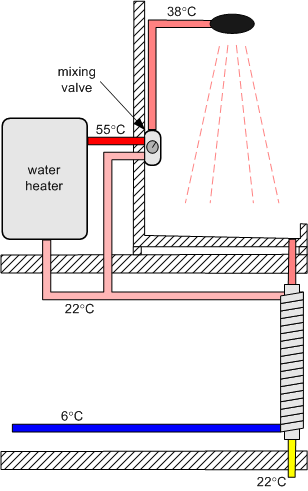
Vertical systems are available in various lengths up to ca 2 meters (6 ft). They need to be installed below the shower, although some horizontal displacement is allowed. Due to the height they are often installed in the basement. Of all types of WWHR, the vertical units are the most effective. This type is produced by a number of manufacturers, both in USA, Canada as well as in Europe.
Shower FLOOR With integrated heat exchanger
The second type of WWHR system, shower floor with integrated heat exchanger, is not as common. They can be used whenever the vertical WWHR is not possible to install. They are typically more expensive and not as effective as the vertical systems. They come in versions where the heat exchanger is integrated in the shower platform, and versiosn where the heat exchanger replaces the drain and is integrated in the floor of the shower.
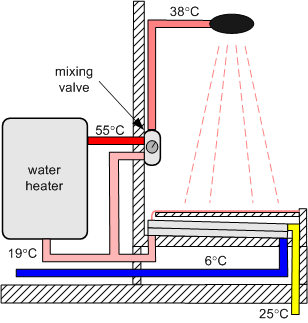
Horizontal systems for installation under the shower
Horizontal units that can be placed close by or under a shower rely on easy access to drain and cold water, but then provide very easy installation. They are most suited as add-ons for shower cabinets and are presently not so common.
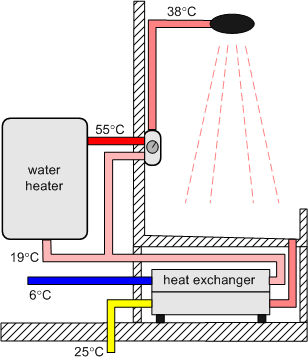
Tank based systems
The fourth type of WWHR uses an insulated tank where the drain water is stored temporarily, and through which the cold water is guided in a heat exchanger. This allows heat recovery also from other household appliances as clothes washer, and dish washer because it doesn’t depend on water draining at the same time as cold water being used.
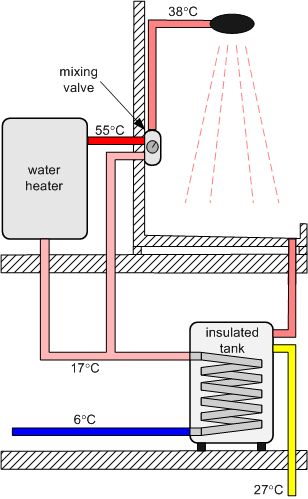
Installation options
There are three ways of installing a WWHR system, depending on how the preheated cold water is used.
The preheated water can be plumbed into both the mixing valve of the shower and into the cold water supply of the water heater. In this case the flow of the drain water is equal to the flow of the cold water through the WWHR system. This is called a balanced-flow setup or ‘System A’ and gives the best performance in terms of energy savings. It also requires most plumbing and installation effort and cost.
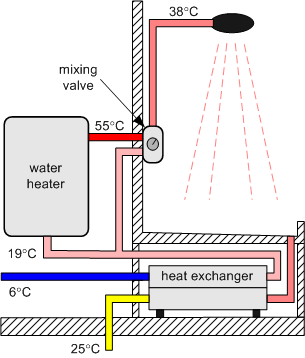
Feeding the preheated water into the mixing valve of the shower only allows the simplest installation: only shower drain and cold water input to the shower mixing valve need to be diverted locally. For this case, the flow is also unbalanced (cold water flow is 30-60% of drain flow, depending cold and hot water temperatures), which again reduces WWHR performance somewhat (15% is reported for a particular WWHR unit). This type of installation is known as ‘System B’.
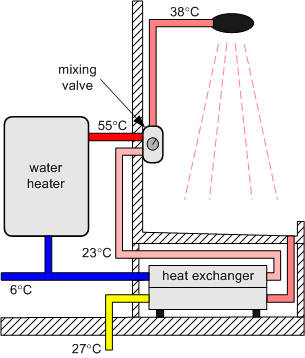
In the third installation option, the preheated water is fed into the cold water supply of the water heater only. The energy savings are due to the preheated water requiring less energy to get up to the temperature setting of the water heater. The flow is unbalanced, because the cold water flow is smaller than the drain water flow, and this reduces the performance of the WWHR to some extent as compared to a balanced flow setup. (The temperature of the preheated cold water could actually be higher but due to its lower flow the total power transferred is less as compared to the balanced flow setup.). This setup is known as ‘System C’.
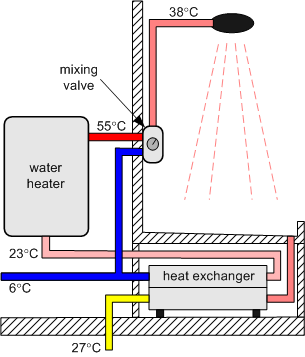
(system C)
For a retro-fit into an existing building, the preferred installation option depends on the relative position of the water heater as compared to the shower, any available space under the shower, ease of access to existing plumbing etc., and should be considered for each case. A new-built house obviously gives much greater freedom in designing in an optimal WWHR system layout.
In principle, all four types of WWHR systems could be used in the install options given above, but typically the shower floor with integrated heat exchanger and the ‘under shower’ horizontal unit are most suited for a local install in the shower and a feed only into the mixing valve. On the other hand, the vertical and tank based systems are typically placed in a separate room (basement, floor under the shower, technical room) where a more extensive install into both water heater and shower mixing valve is a viable option.

